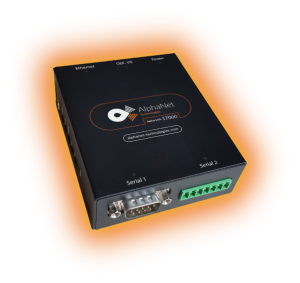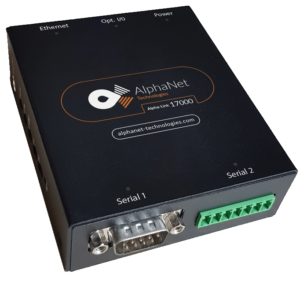The Modbus protocol was developed in 1979 by Modicon, Incorporated, for industrial automation systems and Modicon programmable controllers. It has since become an industry standard method for the transfer of discrete/ analog I/O information and register data between industrial control and monitoring devices. Modbus is now a widely-accepted, open, public-domain protocol that requires a license, but does not require royalty payment to its owner.
Modbus devices communicate using a master-slave (client-server) technique in which only one device (the master/client) can initiate transactions (called queries). The other devices (slaves/servers) respond by supplying the requested data to the master, or by taking the action requested in the query. A slave is any peripheral device (I/O transducer, valve, network drive, or other measuring device) which processes information and sends its output to the master using Modbus. The Acromag I/O Modules form slave/server devices, while a typical master device is a host computer running appropriate application software. Other devices may function as both clients (masters) and servers (slaves).
Masters can address individual slaves, or can initiate a broadcast message to all slaves. Slaves return a response to all queries addressed to them individually, but do not respond to broadcast queries. Slaves do not initiate messages on their own, they only respond to queries from the master.
A master’s query will consist of a slave address (or broadcast address), a function code defining the requested action, any required data, and an error checking field. A slave’s response consists of fields confirming the action taken, any data to be returned, and an error checking field. Note that the query and response both include a device address, a function code, plus applicable data, and an error checking field. If no error occurs, the slave’s response contains the data as requested. If an error occurs in the query received, or if the slave is unable to perform the action requested, the slave will return an exception message as its response (see Modbus Exceptions). The error check field of the slave’s message frame allows the master to confirm that the contents of the message are valid. Traditional Modbus messages are transmitted serially and parity checking is also applied to each transmitted character in its data frame.
At this point, It’s important to make the distinction that Modbus itself is an application protocol, as it defines rules for organizing and interpreting data, but remains simply a messaging structure, independent of the underlying physical layer. As it happens to be easy to understand, freely available, and accessible to anyone, it is thus widely supported by many manufacturers.
What Is a Modbus TCP/IP
Modbus TCP/IP (also Modbus-TCP) is simply the Modbus RTU protocol with a TCP interface that runs on Ethernet.
The Modbus messaging structure is the application protocol that defines the rules for organizing and interpreting the data independent of the data transmission medium.
TCP/IP refers to the Transmission Control Protocol and Internet Protocol, which provides the transmission medium for Modbus TCP/IP messaging.
Simply stated, TCP/IP allows blocks of binary data to be exchanged between computers. It is also a world-wide standard that serves as the foundation for the World Wide Web. The primary function of TCP is to ensure that all packets of data are received correctly, while IP makes sure that messages are correctly addressed and routed. Note that the TCP/IP combination is merely a transport protocol, and does not define what the data means or how the data is to be interpreted (this is the job of the application protocol, Modbus in this case).
So in summary, Modbus TCP/IP uses TCP/IP and Ethernet to carry the data of the Modbus message structure between compatible devices. That is, Modbus TCP/IP combines a physical network (Ethernet), with a networking standard (TCP/IP), and a standard method of representing data (Modbus as the application protocol). Essentially, the Modbus TCP/IP message is simply a Modbus communication encapsulated in an Ethernet TCP/IP wrapper.
Introduction to Modbus TCP/IP
Modbus TCP/IP Application Data Unit (ADU) takes the form of a 7 byte header (transaction identifier + protocol identifier + length field + unit identifier), and the protocol data unit (function code + data). The MBAP header is 7 bytes long and includes the following fields:
• Transaction/invocation Identifier (2 Bytes): This identification field is used for transaction pairing when multiple messages are sent along the same TCP connection by a client without waiting for a prior response.
• Protocol Identifier (2 bytes): This field is always 0 for Modbus services and other values are reserved for future extensions.
• Length (2 bytes): This field is a byte count of the remaining fields and includes the unit identifier byte, function code byte, and the data fields.
• Unit Identifier (1 byte): This field is used to identify a remote server located on a non TCP/IP network (for serial bridging). In a typical Modbus TCP/IP server application, the unit ID is set to 00 or FF, ignored by the server, and simply echoed back in the response.
The complete Modbus TCP/IP Application Data Unit is embedded into the data field of a standard TCP frame and sent via TCP to well-known system port 502, which is specifically reserved for Modbus applications. Modbus TCP/IP clients and servers listen and receive Modbus data via port 502.
We can see that the operation of Modbus over Ethernet is nearly transparent to the Modbus register/command structure. Thus, if you are already familiar with the operation of traditional Modbus, then you are already very with the operation of Modbus TCP/IP.
IEEE 802.3 Ethernet is a long-standing office networking protocol that has gained universal world-wide acceptance. It is also an open standard that is supported by many manufacturers and its infrastructure is widely available and largely installed. Consequently, its TCP/IP suite of protocols is used world-wide and even serves as the foundation for access to the World Wide Web. As many devices already support Ethernet, it is only natural to augment it for use in industrial applications.
Just as with Ethernet, Modbus is freely available, accessible to anyone, and widely supported by many manufacturers of industrial equipment. It is also easy to understand and a natural candidate for use in building other industrial communication standards. With so much in common, the marriage of the Modbus application protocol with traditional IEEE 802.3 Ethernet transmission forms a powerful industrial communication standard in Modbus TCP/IP. And because Modbus TCP/IP shares the same physical and data link layers of traditional IEEE 802.3 Ethernet and uses the same TCP/IP suite of protocols, it remains fully compatible with the already installed Ethernet infrastructure of cables, connectors, network interface cards, hubs, and switches.


